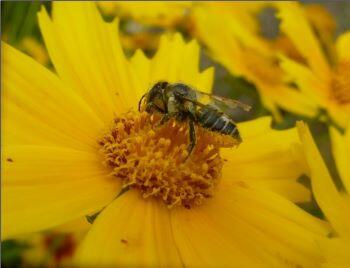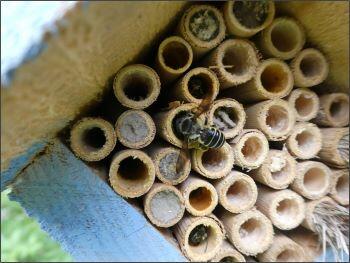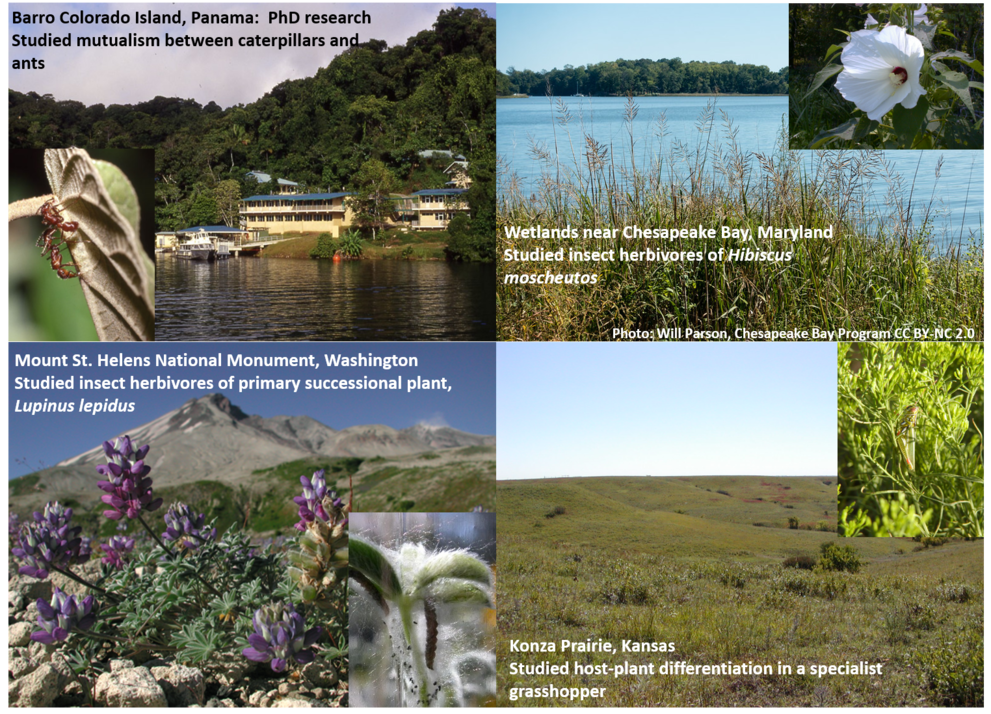Dr. Jennifer Apple has been a member of the Geneseo faculty since 2007.
In the Apple lab, we are pursuing two main lines of research:
- the behavior, ecology, and genetics of a non-native ant-mimicking spider, and
- the ecology and diversity of cavity-nesting bees and wasps on campus.
See more details under My research below.

Office Hours Spring 2024 (in ISC 258)
Wednesday: 11:30 - 12:20 pm
Thursday: 4 - 5 pm
Friday: 8:30 - 9:20 am
Ecology tutor, Lily Peck, available Sun 5:30 - 7 pm and Mon 2 - 3:30 pm in ISC 136
More About Me
I am an ecologist who focuses primarily on species interactions involving insects, spiders, and/or plants using both field-based approaches and molecular methods. Learn more about me below:
- My research
-
Ant-mimicking spiders
Since about 2017, I have been studying an ant-mimicking spider (which I would often see when I was observing ant colonies in the Arboretum, see below). This spider, Myrmarachne formicaria, is in the jumping spider family, but resembles ants in both its morphology and behavior. To pull off the charade, it raises its first set of legs like a pair of antennae, so it appears to be a 6-legged insect instead of an 8-legged spider. This species is native to Eurasia and was introduced to North America relatively recently; so far it is regularly found in Ontario, western New York, eastern Ohio, and northwest Pennsylvania. Here is a poster highlighting recent research on this spider from my lab. Student projects in my lab involve both the behavior of this spider in intraspecific and interspecific interactions, as well as efforts to characterize genetic variation in this species in its invaded range.
Recent student research posters on ant-mimicking spider behavior: 2024, 2022, 2022, 2021, 2020
Recent student research posters on ant-mimicking spider genetics:


Ant-mimicking spider, Myrmarachne formicaria: male (left), female (right)
Native bees
Another area of research in my lab involves characterizing the diversity of native bees on campus as well as their use of artificial cavity nests. Several of my students have conducted systematic surveys of native bees on campus in different habitats and found >40 different species. Recently, we have focused on cavity-nesting bees and their use of artificial nest sites (sometimes known as "bee hotels"). Bees and other insects like wasps will use existing cavities to raise their brood; however there is controversy over whether bee hotels actually do help native bees. We have found that many of these tubes get occupied by early-emerging invasive mason bees, and so we have experimented with the timing of tube placement to benefit native over exotic bees. Students are using these artificial nest sites to characterize patterns of diversity of cavity-nesting bees and wasps across different habitats on campus.
Recent student research posters on native bees: 2024, 2022, 2021, 2020
Leafcutter bee gathering pollen from a flower (left). Leafcutter bee capping a nest tube in which she has laid eggs and deposited provisions of pollen and nectar for her developing young (right).
Past research: kidnapper ants
For over 10 years here at SUNY Geneseo, my main research efforts have focused on the ecology and population genetics of kidnapper ants, Formica subintegra and Formica pergandei (also known as slavemaking ants). These ants are social parasites - they raid the colonies of other ant species (one in particular in the Arboretum, Formica glacialis), kidnap their brood (immature ants, generally as pupae), and when those brood mature in the raiding species' nest, they end up working for their captors. The captured ants do all the foraging for the kidnapper ants' colony, take care of their offspring, perform nest maintenance...all the activities they would normally do in their own colonies, but they happen to benefit a different species instead of their own relatives.

Formica subintegra ants raiding a nest of Formica glacialis to capture brood which will become their labor force. (Photo by Sara Lewandowski '11).
- Mentoring student researchers
-
I mentor student researchers studying a variety of subjects relating to the ecology of insects, spiders, and plants, and their interactions, using both field methods and molecular techniques. Here are some examples of student research projects I have supervised recently:
- Teddy Charlap and Colton Judd (2024-2025). Personality, morphology, and intraspecific interactions in the ant-mimicking spider, Myrmarachne formicaria. Poster
- Milo Miller, Brooke Sikora, and Brenna Dunn (2024-2025). Genetic variation and endosymbiont incidence in the introduced ant-mimicking spider, Myrmarachne formicaria. Poster
- Julia Lingenfelter, Sophia Stang, and Carly Wick. (2024-2025). Nesting Patterns and identities of cavity-nesting bees and wasps on the SUNY Geneseo campus. Poster
- Hannah Reid and Madison Bulkley (2023-2024). Investigating courtship, display behaviors, and personality of ant-mimicking spiders. Poster on KnightScholar
- Daniel Lemon, Emma Parker, and Carly Wick (2023-2024). Nesting patterns of cavity-nesting bees and wasps. Poster on KnightScholar
- Anna Schell and Brenna Dunn (2023-2024). Incidence of bacterial symbionts in the ant-mimicking spider, Myrmarachne formicaria. Poster on KnightScholar
- Anna Schell (2023). Development of molecular markers from the transcriptome of an ant-mimicking spider for population genetic analyses. Poster on KnightScholar
- Eliana Ontiveros-Oberg (2022). Distribution and phenology of the ant-mimicking spider Myrmarachne formicaria in its native and invaded range. Poster on KnightScholar
- Julia Brzezicki, Marlena Ridley,and Julia Cappiello. (2021-2022) Does male display behavior in an ant-mimicking spider depend on context and affect female response? Poster on KnightScholar
- Stephen Hoare, Rachel Williams, and Kaitlyn Latorre (2021-2022). Timing of use of artificial nests by exotic mason bees. Poster on KnightScholar
- Cassidy Mills (2021-2022): Developing resources for assessing genetic diversity in a non-native ant-mimicking spider. Poster on KnightScholar
- Cassidy Mills (2020 - 2021): Genetic diversity of a non-native ant-mimicking spider, Myrmarachne formicaria, in its invaded range Poster on KnightScholar
- Alli Menendez: Evaluating the use of artificial nests by native bees (2020 - 2021) Poster on KnightScholar 2020 2021
- Julia Ophals and Niaomi VanAlstine: Success of Batesian mimicry in the ant-mimicking spider Myrmarachne formicaria (2020-2021) Poster on KnightScholar
- Bea Dipzinski and Alanna Richman: Effectiveness of Batesian mimicry in the ant-mimicking spider Myrmarachne formicaria (2019-2020) Poster on KnightScholar
- David Korb (2020): Monitoring wildlife activity at the campus compost pile Poster on KnightScholar
- Daniel Fleischman: Genetic diversity of a non-native ant-mimicking spider, Myrmarachne formicaria, in the Great Lakes (2019-2020)
- Samantha Muscat: Herbivory and arthropod abundance on native and invasive understory shrubs (2018-2019)
- Alanna Richman: Relationship between the incidence of an ant-mimicking spider (Myrmarachne formicaria) and ant abundance and diversity (2018-2019)
- Christine Schultz: Exploration of fox den family dynamics using camera trap data. (2018-2019)
- Jacqueline Zhou: Display behaviors in encounters between males of the ant-mimicking spider Myrmarachne formicaria (2018-2019)
- Sam Heraghty: Patterns in native bee diversity: effects of floral resources and habitat (2017-2018).
- Ally Jones: Interactions between beech blight aphids, sooty mold fungus, and forest invertebrates (2017-2018)
- Emily Martin: Extended leaf phenology of the invasive Amur honeysuckle (2017-2018)
- Kevin Zablonski: Genetic comparison of slavemaking ant colonies to complement assays of aggression between nests (2017-2018)
- Courses I teach
-
Here are recent syllabi from courses I typically teach:
BIOL 203 - Principles of Ecology
- Roemer Arboretum
-
From 2013 - 2021, I managed the Spencer J. Roemer Arboretum, which I encourage you to visit frequently! I still do research out there and I am still involved in maintaining its native plant gardens. It is a lovely place to take a walk, relax, and to witness cool natural history. Check out our website and Facebook page. See some of the organisms reported there on our iNaturalist page.
Here is some information about planting natives in the Arboretum.
- Past research adventures
-
I have been fortunate to have been able to pursue research in a variety of study systems and habitats--this photo collage provides an overview:
Jenny Apple's CV
Curriculum Vitae
Education
Ph.D. in Biology, University of Utah, May 2001
B.S. in Biology, University of Puget Sound, 1994
Research Interests
Arthropod ecology
Ecology of plant-insect interactions
Molecular ecology
Publications
Apple, J.L., S.L. Lewandowski,* and J.L. Levine*. 2014. Nest relocation in the slavemaking ants Formica subintegra and F. pergandei: a response to host nest availability that increases raiding success. Insectes Sociaux 61:347-356. (* undergraduate co-authors)
Apple, J.L., T. Grace, A. Joern, P. St. Amand, and S.A. Wisely. 2010. Comparative genome scan detects host-related divergent selection in the grasshopper Hesperotettix viridis. Molecular Ecology 19:4012-4028.
Bishop, J.G., N. O?Hara, J.H. Titus, J.L. Apple, R.A. Gill, and L. Wynn. 2010. N-P co-limitation of primary production and response of arthropods to N and P in early primary succession on Mount St. Helens volcano. PLoS ONE 5:e13958.
Apple, J.L., M. Wink, S.E. Wills, and J.G. Bishop. 2009. Successional change in phosphorus stoichiometry explains the inverse relationship between herbivory and lupin density on Mount St. Helens. PLoS ONE 4:e7087.
Adamski, D.A., J.L. Apple, and J.G. Bishop. 2009. A new Filatima Busck (Lepidoptera: Gelechiidae) associated with lupine and early herbivore colonization on Mount St. Helens. Proceedings of the Entomological Society of Washington 111:293-304.
Grace, T., A. Joern, J.L. Apple, S.J. Brown, and S.M. Wisely. 2009. Highly polymorphic microsatellites in the North American snakeweed grasshopper Hesperotettix viridis. Journal of Orthoptera Research 18:19-21.
Apple, J.L., and D.A. Adamski. 2006. The biology of Chionodes hibiscella (Busck) with a description of the immature stages. Proceedings of the Entomological Society of Washington 108:575-582.
Gill, R.A., J.A. Boie, J.G. Bishop, L. Larsen, J.L. Apple, and R.D. Evans. 2006. Linking community and ecosystem development on Mount St. Helens. Oecologia 148:312-324.
Fagan, W.F., M.A. Lewis, M.G. Neubert, C. Aumann, J.L. Apple, and J.G. Bishop. 2005. When can herbivores slow or reverse the spread of an invading plant? A test case from Mount St. Helens. American Naturalist 166:669-685.
Apple, J.L., and D.H. Feener, Jr. 2001. Ant visitation of extrafloral nectaries of Passiflora: the effects of nectary attributes and ant behavior on patterns in facultative ant-plant mutualisms. Oecologia 127: 409-416.
Classes
-
BIOL 203: Principles of Ecology
A study of the interrelationship of organisms and their environment, with an emphasis on how ecological principles govern local and global patterns and processes. Throughout the course, students will apply ecological concepts to understand the interdependence of human activities and the environment, in the context of global change and conservation.
-
BIOL 345: Biology of Insects - Lec
A survey of the diversity, classification, morphology, physiology, behavior, ecology, and evolution of insects, and their relevance to human activities.
-
BIOL 345: Biology of Insects - Lab
A survey of the diversity, classification, morphology, physiology, behavior, ecology, and evolution of insects, and their relevance to human activities.


